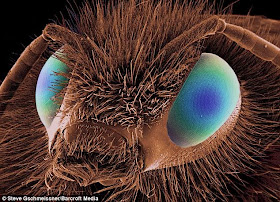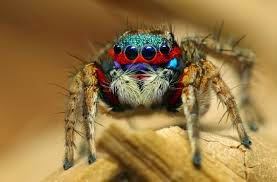 |
| "Isotoma Habitus" by U. Burkhardt - Springtail... as many as 100,000 per square meter of ground. |
The trouble with pesticides, herbicides, and fungicides is their overall killing effect - indiscriminate. To wipe out one pest, which is unlikely anyway, one must kill all the beneficial creatures (like spiders) while removing the food from their mouths. Why would beneficial creatures move into one's garden when their food is gone?
The Mole
An interesting case is the mole. The short answer is - there is no solution short of killing all the life in the soil, which will defiitely drive the moles away. The lawn poison advises on the package - "Do not let your children play in the grass afterwards."
Moles do make the soil uneven - scandal! - but they do so while eating lots of insect grubs and mixing the soil. They eat earthworms too, but the earthworm population will fix itself - based on the food and water made available. Moles cannot eat all the earthworms but man can kill all the earthworms temporarily while getting rid of moles.
Let's say you have killed all the moles - temporarily - they always come back. What will the robins eat? I always see them eating earthworms. One hid behind a rose bush and peeked out, because he wanted to keep foraging. Another was gathering dead grass for the nest and looked at me - his beak packed with the material - as if to say,"What concern is this of yours?"
.jpg) |
| By Norma Boeckler |
Robins eat -
- Chokecherries,
- Grapes,
- Cherries,
- Blueberries,
- Poison Ivy,
- Hawthorn fruits,
- Grasshoppers,
- Earthworms,
- Beetle grubs,
- Caterpillars,
- Cutworms,
- Small snakes,
- Mollusks,
- Fish fry (baby fish), and various insects.
I see a lot of creatures no one likes in the garden. I do have grasshopper damage, but that is always short-lived and minor. The grasshoppers attract grasshopper eaters, and soon the damage stops.
The sunny garden is packed with decomposing straw, leaves, and shredded wood. Birds always eat there, all day long.
 |
| Insecticides are very effective against bees, so do not use them outside. |
My Guide for Beneficial Insects Says -
You may have noticed that I mentioned cutting down and cleaning up the border each spring. This is something most folks tend to do in the fall, but it’s far better for your bugs to hold off on this duty until late the following spring. Remember, an insectary border doesn’t serve just as a nutritional source for beneficials; it also provides greatly needed overwintering habitat. When we cover our yards with a monoculture of grass and just a smattering of evergreens and flowering shrubs, and collect every fallen leaf and twig, we essentially eliminate the sheltered sites that insects of all sorts rely on to see themselves safely through the winter months.
Maintaining your insectary garden requires as much, or as little, work as you desire. Just don’t cut down your insectary plantings in the fall, as they provide much-needed overwintering habitat to many beneficials. Though I probably can’t convince you to return your yard to its prehuman native state (nor do I think it’s even feasible), I do encourage you to allow your insectary border to stand as is through the winter. The leaves and dead stems collected there serve as critical good bug habitat. In my opinion, they also add texture and interest to what may otherwise be a very bland winter landscape.
Walliser, Jessica (2014-02-26). Attracting Beneficial Bugs to Your Garden: A Natural Approach to Pest Control (Kindle Locations 3238-3243). Timber Press. Kindle Edition.
 |
| Honeysuckle vine - it draws insects that hummingbirds love. Hummingbirds eat more than cola from plastic feeders. They love insects and need insects to live. |
Tree Branches Left a Mess in the Front Yard
The pruned branches left a mess in the front yard - dried leaves and twigs. We will rake the debris under the front yard maple tree to feed the tree, flowers, and garlic.
Jessica Walliser and Sharon Lovejoy are saying, "Let the insects do their work, and give them all the food, water, and shelter possible."
I simply keep all organic matter in the yard, in place wherever possible.
- The lawnmower mulches grass and weeds into the soil to add food rather than take it away.
- Weeds grow as groundcover and shoot up as mineral miners. At their worst, they are trimmed to be mulch. Many tall weeds are handy as insect havens and food for the compost (comfrey, pigweed) or food for me (goosefoot). Insects like Queen Ann's Lace (wild carrot).
- Leaves remain to decompose into the soil and harbor such beneficial creatures as rove beetles.
- A tangle of branches is left near the Jackson Bird Spa to help birds feel at home, a safe perch close to their food, but also a place where food can be found in the bark.
- Extensive mulching is the best bird feeder of all, large, varied, and full of life below.
- No pesticides - but almost no pests).
- No herbicides - but no weed problem. Crabgrass (a grain that escaped) is an opportunity for mulching into fertilizer, not a plant to hate and destroy with chemical warfare.
- No fungicides - but a fungal jungle, fed by wood products and left to serve its Creator's purpose in decomposing organics and delivering food to the roots of plants.
- A compost pile awaits its distribution this year, so the chicken wire can receive new batches or organic material to improve the soil. If you doubt the power of decomposition, create a pile and watch it shrink while building up an army group of earthworms. Our blue jay in Midland sat on the chicken wire waiting for his next meal to wiggle near the top of the compost.
 |
| A garden spider is a beautiful site. |
 |
| Handsome guy - does anyone wonder how he spots his food? His legs feel the motion and his eyes are more effective than a mother's. |
 |
| When I put down mulch I see spider webs appear at once. Dinner is served, and my problems are digested. Aphid spray is very effective against spiders. I have no spray and no aphids. |
